There are plenty of search engines out there to find a cheap flight. Maybe you've got a favorite airfare tool like Skyscanner, Hopper, or an online travel agency like Priceline or Expedia. But one option is better than all the rest: Google Flights.
Yes, that's right. The search engine behemoth Google is also king when it comes to finding cheap flights. Google Flights is incredibly powerful, with tons of features that will help you zero in on the best prices for your flights. It's got a bevy of filters you can use to find the best flights you really want – and avoid the ones you don't.
It's gotten even better over the years, adding new features that help you zero in on the cheapest time to book your flight, find and book Southwest fares, or even book a trip by train instead. Most recently, the site began testing the most-requested feature by far: filters to exclude stingy basic economy fares!
We'll show you some of the best tips and tricks to book your next cheap flight at the lowest price. When you're done, you'll never use another flight search engine again.
- What is Google Flights?
- How to Use Google Flights
- Find the Cheapest Flights with Thrifty Traveler Premium
- New: Find & Book Southwest Fares!
- What's a Good Flight Deal? Google Flights Will Tell You
- Price Guarantee: Get a Refund if Prices Drop Again
- How to Find the Cheapest Getaway with the Explore Feature
- How to Set Price Alerts
- “Cheapest Time to Book”: Google Flights' Newest Feature
- What Airlines are Not on Google Flights?
- Frequently Asked Questions
What is Google Flights?
There's a reason why we recommend this site above all others. It's the tool we personally use here at Thrifty Traveler to find cheap domestic and international flights.
But let's back up a bit and explain the basics. Let's start with the most important basic of all: The Google Flights search engine isn't like Expedia, Orbitz, or almost any of the other popular travel search engines.
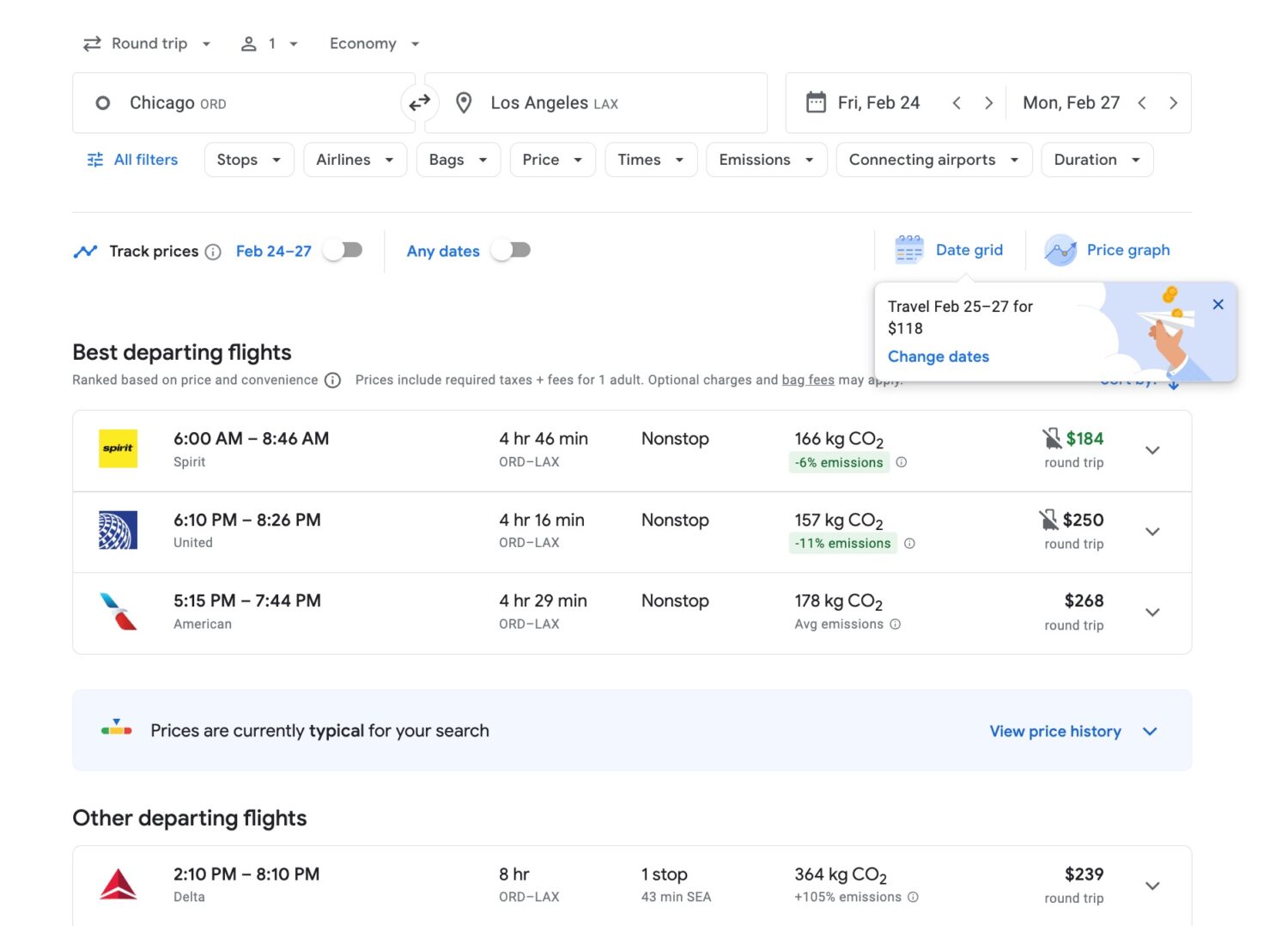
Many of those platforms are called online travel agencies or OTAs, where you actually buy your flight, hotel, cruise, or other travel. Google, on the other hand, operates as a global distribution platform where airlines directly publish their airfare. Occasionally, you'll also find some fares on major OTAs like Expedia or Priceline, too.
So you're not actually buying your flights from Google – the web giant is just pointing you toward the cheapest price. That makes Google Flights a powerful one-stop shop for flights.
How to Use Google Flights
This is the easy part. Start your flight search by visiting Google Flights at https://www.google.com/travel/flights.
While there is no shortage of other Google apps, there is no app. You can use it on a smartphone web browser, but we think using the desktop version is best.
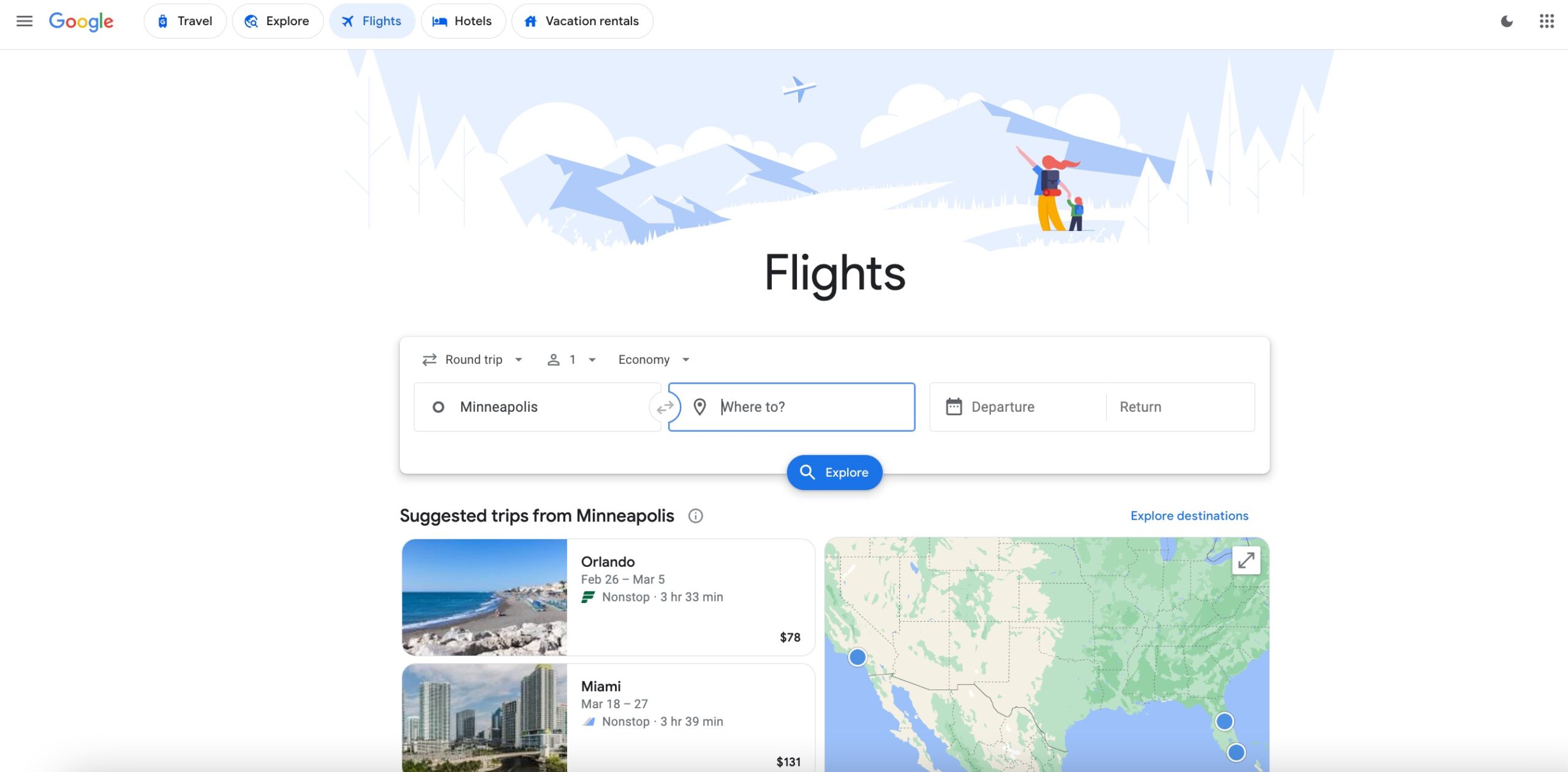
The homepage is user-friendly, quickly giving you results of flights you can book based on what you enter for your departure location, travel destination, dates, and more. Here's a quick breakdown of what you'll see.
- The Menu in the top left corner (three dashes) gives you shortcuts to Search Flights, Google Flights Explore, and Tracked Prices (where you can track price changes for a flight – more on this later). You can even search for hotels. Finally, this is also where you can change your country, language, and currency – a valuable feature, depending on where you're searching from.
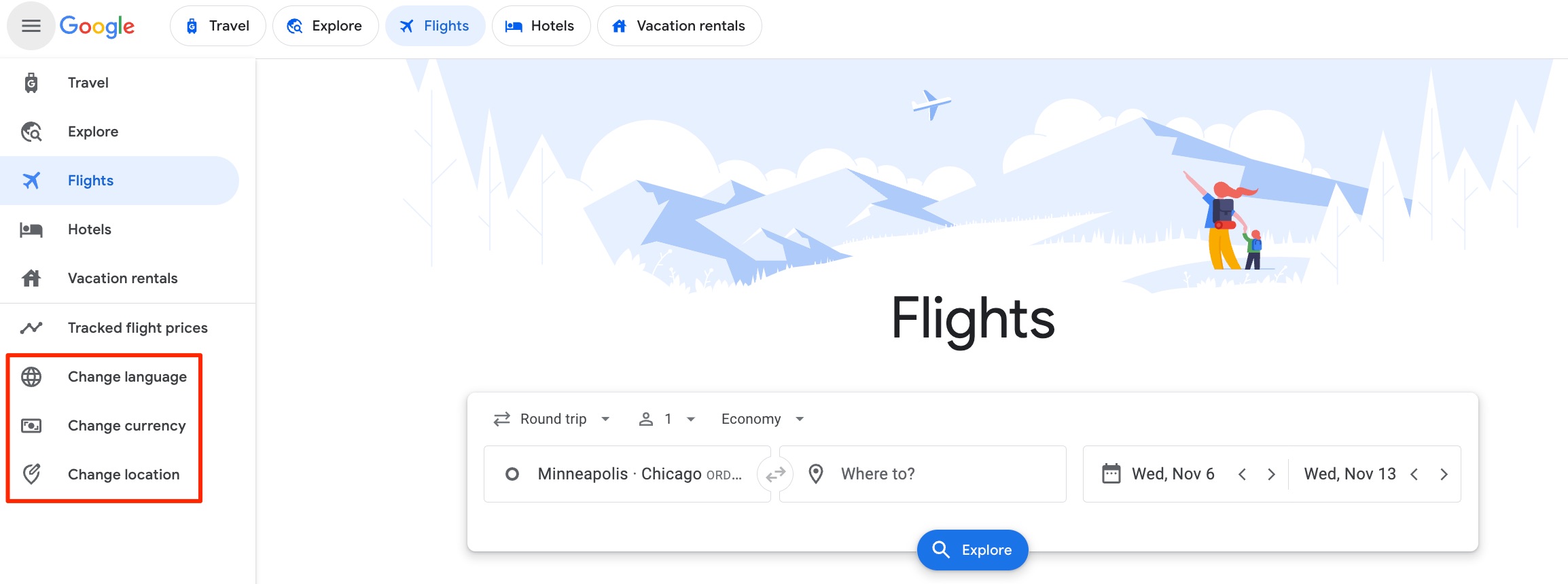
- Flight Search is where you can enter information to start your flight search in the middle of the homepage. You can enter:
- Departure Airport: You can choose up to seven departing locations to find cheap flights
- Destination: You can enter up to seven locations to fly to as well
- Dates of Travel
- Type of Trip: Roundtrip, One way, or Multi-City
- Numbers of Passengers: Adults, children, infants in seats, and infants in laps
- Airline Class: Economy, Premium Economy, Business Class & First Class.
How to Filter Your Results to Fit Your Travel Needs
Sometimes, not just any flight will do. We've all got wants and needs, after all … and Google Flights makes it easy to make sure you get them with a ton of options to filter your flight results.
Looking to take a first-class flight for your honeymoon? Need to depart after a certain time? Only want to fly a specific airline? Don't worry, Google has taken these things into consideration.
How to Search to and From Multiple Destinations
One of the most powerful features of Google Flights is the ability to search to and from many different cities at the same time. You can search for up to seven origin and destination cities simultaneously, in fact.
Why does it matter? Let's say you're looking for flights from Minneapolis-St. Paul (MSP) to Rome (FCO) for a trip to Europe this fall, but you'd be willing to fly into Amsterdam (AMS), Paris-Charles de Gaulle (CDG), Madrid (MAD), Lisbon (LIS), or other European cities if it meant you could get a cheaper deal. Heck, you'd even depart from Chicago-O'Hare (ORD), New York City (JFK), Newark (EWR), Boston (BOS), or Washington, D.C.-Dulles (IAD) if it saved you more.
Google Flights makes it easy to check. Just click into your departure city and select the plus sign to add multiple airports.
Start typing in the additional airport or city name you'd like to search and click to add it. Already, that brings down the price by nearly $300 per person by showing you results from Washington, D.C.
Repeat the same process with destination cities if you want. Remember, you can add up to seven destination airports.
Casting a wide net is key to finding the best deal, especially if you're hoping to fly somewhere far abroad. And Google Flights makes it incredibly easy to do so.
How to Book Flights Directly with Airlines
This is one of the primary reasons we love Google's flight searching capabilities: Rather than booking through another site that will handle your reservation, you can cut out the middleman and book your airfare directly with the airline.
Unlike an online travel agency or a third-party search engine like Expedia or Priceline, you can book directly with the airline through Google Flights. On the final page, you'll be directed to book on the airline's website – along with other sites that may have fares available.
Google Flights even displays the price differences between basic economy fares (which often come without free seat assignment and, in the case of United basic economy, without a carry-on bag), economy fares, extra legroom economy seats like Delta Comfort Plus, and sometimes even first class fares.

Just click “Select” on the fare you want, and Google will take you straight to the deal you just found to book directly with your selected airline. It's that simple.
How to Use the Calendar View to Find the Cheapest Days to Fly
Finding the cheapest flights is all about flexibility. And part of Google Flights' power is how easy it makes it to find the cheapest days to travel.
It starts with its calendar view, which breaks down the cost of the flights you're looking at over a two-month span. Dates in green immediately tell you that they're your best bet to fly for cheap.

But Google has upped its game even more to help you find the cheapest dates to fly. If changing your travel dates by just a date or two would save you big bucks, Google will give you a quick pop-up alert to let you know.

Click the date grid, and Google will pull up a handy, color-coded chart showing you the cheapest dates to fly based on departure and return dates. Sometimes, shifting your dates slightly can save you $20 or more. Other times, those savings can be hundreds of dollars.
You can also display this in a price graph, which allows you to tailor your search based on how many days you want your stay to be.
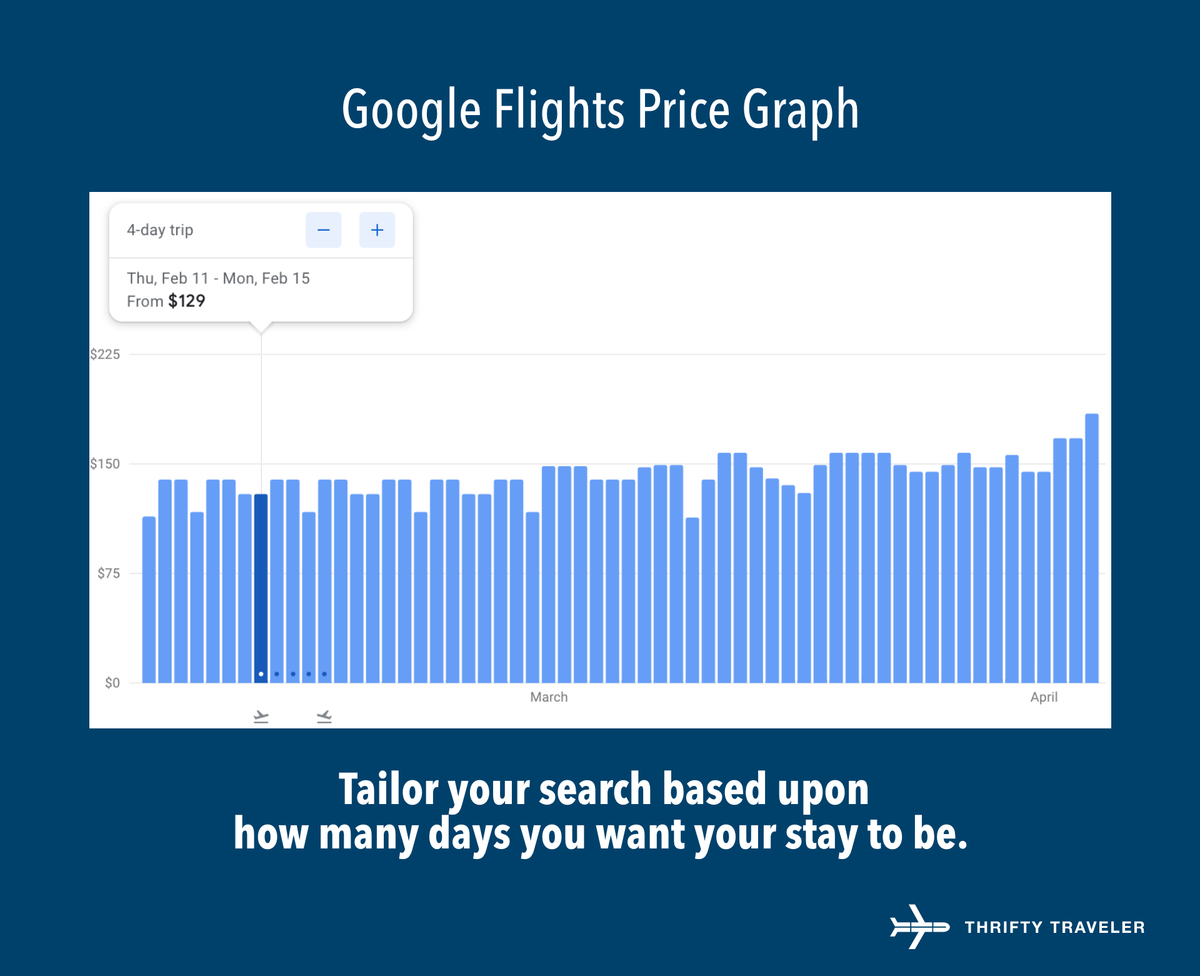
No other flight search engine gives you more information to save on airfare than Google Flights.
New: How to Sort for the Cheapest Fares
Google is always making its airfare search engine better and better. One of its newest features can help you instantly zero in on the absolute cheapest flight deal.
In the fall of 2024, Google added a brand new “Cheapest” tab to its search results. Just click that, and the cheapest fares results will automatically get brought to the top of the list.
If saving money on flights is your #1 priority, this is an easy way to instantly focus on the least-expensive fares. Just keep in mind that these cheapest options could come with tradeoffs, like:
- Making a connection (or several) while other flights are nonstop
- Requiring an overnight connection en route to your final destination
- Booking one-way flights separately with two different airlines, rather than a simple roundtrip with one carrier
How to Search by Preferred Airline
Have a favorite airline you're looking to fly – or a few you swear you'll never book? Google makes it easy to filter your results and only see flights and prices for the airlines you care about.
Right after beginning your search, you should see the”Airlines” filter. Click it, and you'll see a drop-down of all the airlines flying the route you're searching.
This is particularly useful for travelers who are looking to earn elite status with their go-to carrier … or get the perks like free baggage or complimentary upgrades from the status they've already earned. If you've already got (or are chasing) Delta Medallion Status, for example, just hover over Delta, and you'll see the option to see only results on Delta Air Lines.
You can also filter to see results from several airlines … while excluding others. This comes in handy if you'd prefer to avoid ultra-low-cost carriers like Spirit, Frontier, Allegiant, or Sun Country. Just click the checkmarks next to airlines you'd rather not see to remove them from your filters.
Finally, there's also an option to filter your results by the three big airline alliances: Oneworld, SkyTeam, and Star Alliance. That can be incredibly helpful when you're searching for international flights but would prefer to fly, for example, a Oneworld carrier that will help you earn status and miles with American or Alaska Airlines: the two big Oneworld U.S. carriers.
These filters are incredibly powerful to find flights only on the airlines you want to fly. But that could come with a price.
Loyalty to your go-to airline can cost you big bucks. Oftentimes, the best way to get a cheap fare is by flying another carrier – one that isn't dominant at your home airport. And if you filter only for one airline, those are the only prices you'll see through Google Flights: You might miss out on a much cheaper deal on a competitor.
How to Filter By Number of Stops & Connecting Airports
Want to get to your final destination as soon as possible? Or avoid connecting through certain airports on your way to Europe? Or limit nasty, overnight layovers? No problem.
Google Flights' “Stops” filter is the place to start. Within just a few clicks, you can limit your results to nonstop, one-stop, or multi-stop journeys.
That's particularly helpful for when you're looking for the quickest, nonstop flights within the U.S. No one wants to make a connection on the way to Chicago-O'Hare (ORD) or New York City (JFK), right?
If there are no nonstops offered between the airports you're searching, you'll see that option is grayed out.
But this nonstop filter can cost you, too. Particularly for international flights overseas, taking a trip with a connection en route to your final destination is almost always cheaper than a nonstop flight.
But other filters can help you drill down even further. Even if it saves you a few bucks on the trip from Minneapolis-St. Paul (MSP) to Tokyo-Haneda (HND), is it really worth making a 17-hour stop in Toronto (YYZ)? No. Using the “Duration” filter, you can eliminate flights that include nasty layovers.
Sometimes, making a connection is unavoidable … but some connections are worse than others. For example, I'd always try to avoid connecting through London-Heathrow (LHR) on the way to Europe. Paris-Charles de Gaulle (CDG) isn't much better – connecting through either airport is often a huge hassle.
Luckily, Google Flights lets you filter out connections by airport, too. Just click “Connecting airports” and you can toggle off any airports you'd rather avoid.
Just like Google's many other filters, these are incredibly powerful. But you can go too far: If you eliminate too much from your search results by filtering out lots of connecting airports or focusing only on nonstop flights, it will wind up costing you.
How to Get the Best Legroom and Amenities
Everyone wants a cheap flight, first and foremost. But comfort comes second: More legroom is always better – especially on longer flights, right? And a seatback screen to watch a movie or Wi-Fi onboard would be nice, too.
Google Flights has you covered there, too. In addition to all the data on your schedule and pricing, this search tool can give you all the information you need to pick the right flight. That includes:
- Legroom on each flight
- Whether there's a seatback TV
- Or entertainment you can stream from your own devices
- The charging situation: USB, universal power socket, or both
- Is there Wi-Fi onboard?
But you won't see any of that right off the bat. To get all the information on legroom and amenities, you'll want to expand the details on each fare.
On these SWISS flights from Chicago-O'Hare (ORD) to Prague (PRG) via Zurich, for example, you can see that you'll have about 31 inches of legroom, in-set USB power, on-demand video at your seat, and Wi-Fi available for a fee for the long-haul flight to Switzerland. But on that second flight over to Prague, you'll have just 29 inches of legroom … and none of those other extra amenities.
This kind of information is incredibly valuable if you want to get more legroom on a flight within the U.S. For example, you can expand the options on these flights between Minneapolis-St. Paul (MSP) to Denver (DEN) and see that the legroom varies from as much as 31 inches … to just 28 inches of legroom.
These displays are also incredibly helpful if you're aiming to fly business or first class, too. For example, Google Flights will tell you whether you'll have an outdated angled-flat seat that doesn't recline all the way into a bed; lie-flat seat; or maybe even an individual suite complete with closing doors for more privacy, like a Delta One Suite or Air France's newest business class.
Know Your Baggage Limits
When you're booking flights, prices can be deceiving. A $29 flight might seem like a steal at first … until you realize what you get and what you don't. And baggage fees can add up fast.
Google Flights also breaks down the baggage policies of each fare, whether you're wondering if you can bring a carry-on bag or worrying about the cost of checking a bag. And it varies wildly from airline to airline – especially ultra-low cost carriers like Spirit or Frontier.
For example, scan this list of tickets from Minneapolis-St. Paul (MSP) to Denver (DEN). Those $29 fares from Frontier might seem tempting … until you see that icon on the right, which means you can't even bring a carry-on bag for free. The same goes for those cheapest, United basic economy tickets at $89 each way.
Click that Delta ticket instead for $89 each way and you'll see that a carry on is free while a checked bag will cost you an extra $35 each way – whether you book the cheapest Delta basic economy ticket or a standard economy fare.
And then there's Southwest, which is more expensive at $109 each way … but not necessarily. As Google shows you, you still get not one but two checked bags on this Southwest ticket – and every Southwest fare, for that matter. Since it would cost another $35 to add a checked bag to that Delta fare, Southwest is actually the cheapest option if you need to bring checked luggage.
Know Your Carbon Emissions
Want to limit your carbon footprint? Google Flights has the data to help steer you toward the greenest choice.
With few exceptions, almost every fare you see on Google Flights includes an estimate of its carbon emissions. The lower the carbon emissions, the greener the flight!
A handful of factors go into determining the estimated carbon emissions from each flight, including:
- Nonstop flights are almost always more environmentally friendly than a one- or two-stop journey
- Newer planes are more efficient and, therefore, have lower carbon emissions
- Larger planes that fit more passengers can be more environmentally friendly
- Because you take up more space on the plane, business and first class tickets have higher carbon emissions
All that said, these numbers aren't perfect. Still, it's a helpful way to consider your carbon footprint and steer you towards a more environmentally friendly option.
You can find the cheapest flights all on your own. But it's also the best way to book the absolute best deal on a cheap flight alert we send you via Thrifty Traveler Premium.
We'll send you a Premium alert when there's a cheap flight deal (at least $250+ off) from your hometown. This email alert will include information on the airlines, months available, tips for exploring the destination, and more. Follow the booking instructions in the flight deal alert to search that cheap flight deal from your home airport on Google, book directly with the airline, and save hundreds.
For example, we recently sent Thrifty Traveler Premium members this unbelievable deal on flights to Barcelona this spring for under $400 roundtrip.

Just open the email, click the link, and you'll see some unbelievably low fares you can book within a minute or two. We do all the hard work for you.
Thrifty Tip: Don't have Premium yet? Learn more about how Thrifty Traveler Premium works.
New: Find & Book Southwest Fares!
For many years, one of the few downsides of using Google Flights to find cheap airfare is that you wouldn't see prices to book Southwest Airlines. You haven't been able to find those fares anywhere aside from directly Southwest.com, in fact.
That has changed.
One day in late May 2024, Southwest fares suddenly began appearing in Google Flights searches. No matter whether you're looking for a short domestic hop or on one of Southwest's routes to Mexico, the Caribbean, or even Hawaii, you'll now see Southwest routes and prices alongside the likes of American, Delta, United, and other carriers.
This is huge. Including Southwest turns Google Flights into the one and only true one-stop shop to compare prices between airlines.
It's unclear how long this will last – Southwest calls it a pilot partnership. Southwest fares could be here on Google to stay for good, or they could eventually disappear again. But for now, it makes Google Flights even better.
What's a Good Flight Deal? Google Flights Will Tell You
“Is this a good deal? Am I getting ripped off?”
That's the constant question for almost every traveler on the hunt for a cheap flight. Unless you spend all day, every day looking for airfare, it's tough to know whether the flight you've found is actually saving you money. Google Flights has the answer.
One of our absolute favorite features of this search engine is that Google actually crunches the numbers to let you know how the flight price you've found compares to the average. Think about it: Google has millions upon millions of individual fares in its database. They know what's up.
Just scroll down after selecting a flight and you'll see a handy chart showing how your price stacks up to the norm. In this case, this flight from Minneapolis-St. Paul (MSP) to Chicago-O'Hare (ORD) is substantially lower than the average.
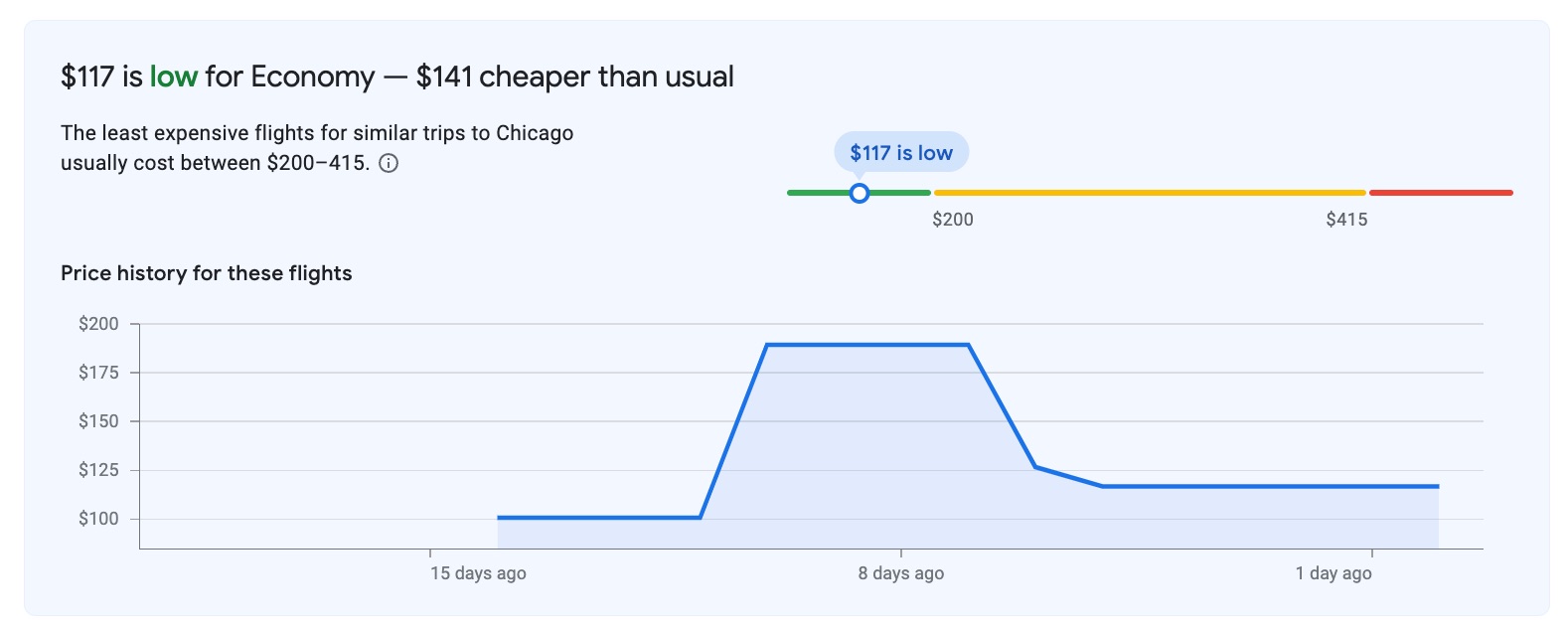
Of course, that's not always the case. In addition to tipping you off when changing your dates can save you a small (or large) fortune, it will also show you when flights are abnormally expensive.
Price Guarantee: Get a Refund if Prices Drop Again
One of the platform's latest (and potentially greatest) features could wash away your worries that prices may drop after you book. Google calls it “Price guarantee.”
After testing it for several months, Google officially unveiled this latest powerful feature in April 2023. And it's just what it sounds like: If prices on select flights drop after you book, Google will cut you a refund for the difference. Payouts are capped at $500 a year.
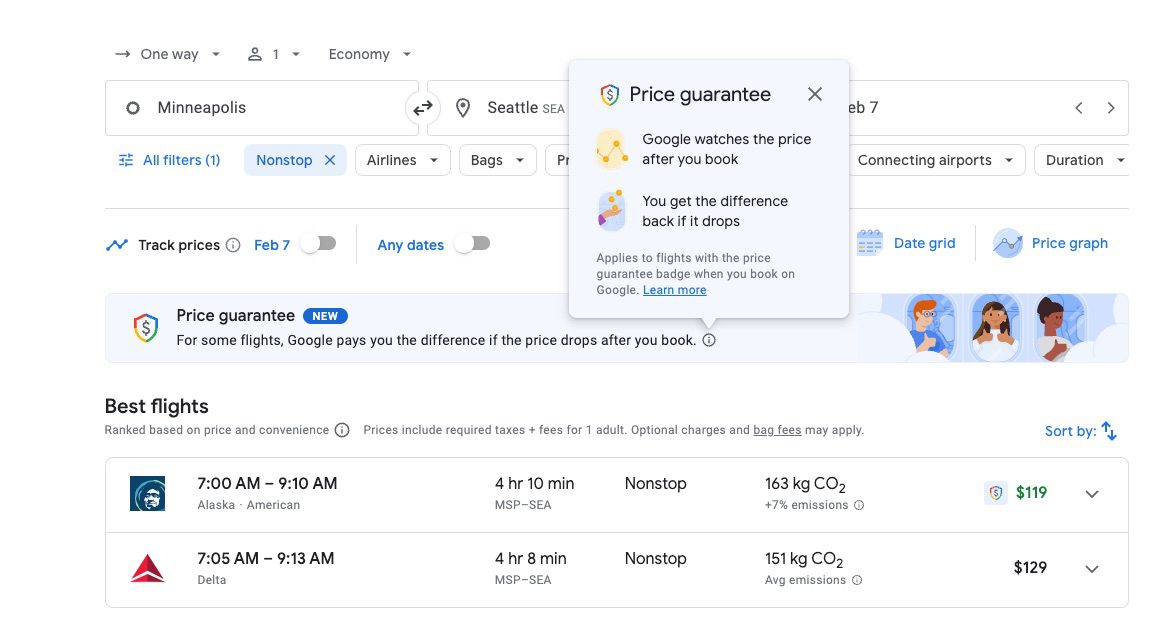
To start, you won't see the price guarantee option on every single Google Flights fare you see here: It's only available on flights departing from the U.S. For now, you're most likely to see it on flights with Alaska Airlines, Hawaiian, and Spirit. You have to book your flights through the “Book on Google” checkout platform and have Google Pay set up to be eligible for a refund.
While you won't see the price guarantee option everywhere just yet, we wouldn't be surprised to see it become a fixture on Google Flights in the future.
Read more on how to get a refund when prices drop!
How to Find the Cheapest Getaway with the Explore Feature
Not sure where you want to go? Do you want to travel somewhere in June but need ideas? Google Flights Explore is a great way to find the cheapest options when you don't care where you're heading.
Here are some tips on how to use the Explore feature:
- Enter your departure city and a destination as specific (or as broad) as you want to check out: California, the United States, Europe, South America – they'll all work.
- Select the dates you'd like to travel or select flexible date guidelines. Play around with travel dates, as pricing can greatly fluctuate – and keep it broad if you can. If you've got specific dates, you can search as far out as you want. If your travel schedule is more broad, you can only search for flights in the next six months.
- Move the map around to see new destinations and prices.
- Once you find a destination that you'd like to explore further, click the name of the city, then “View Flights” and it will populate the search information with flight options and additional details just like a normal Google Flights search
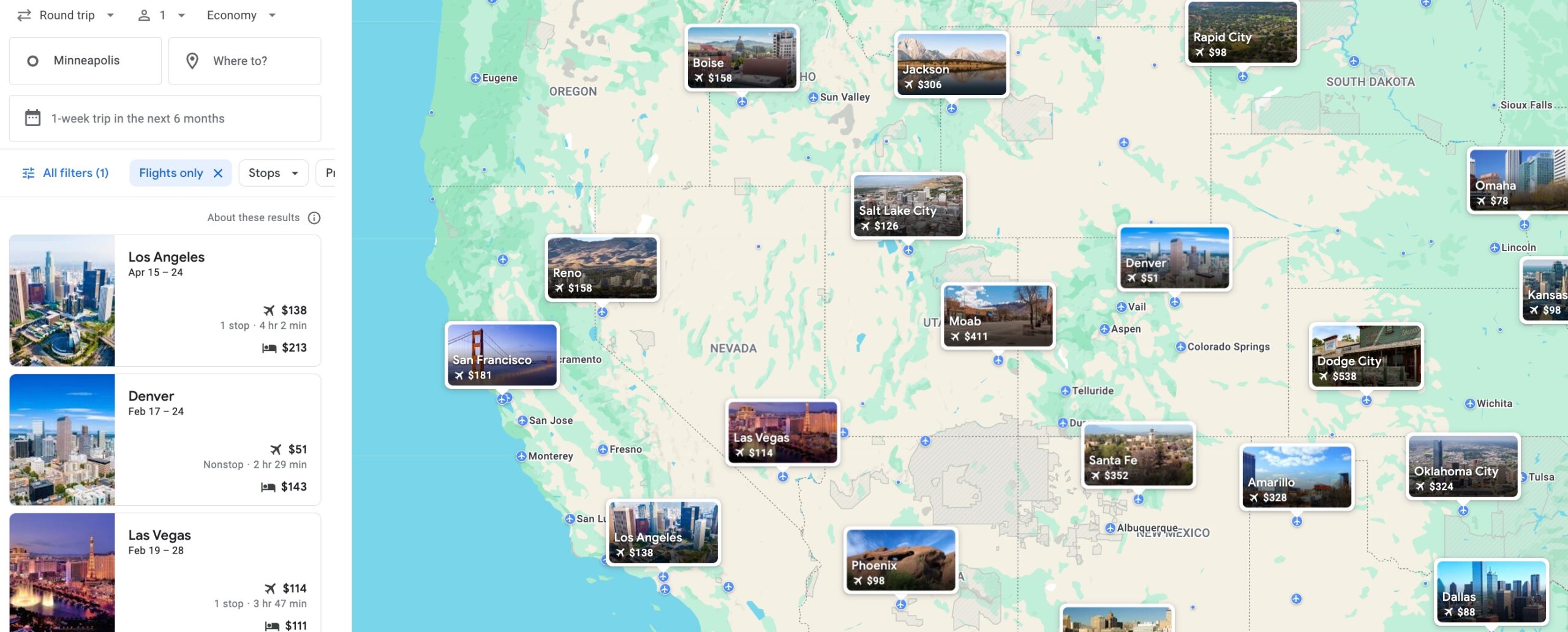
Read our full guide to using Google Flights Explore!
How to Set Price Alerts
If you've ever stressed about the price of your flight increasing (or dropping after you book), you're covered here, too.
You can monitor changes to airfare with Google Flights Price Alerts. This is the perfect tool if you've got to fly on specific dates and want to make sure you get the best deal possible.
Go to Google Flights and start by searching for the flights you want. You can narrow it down as far as you want, drilling down to just one preferred airline – or even just one flight – or leave it wide open and look for the cheapest fare possible. You can get alerts only for fares that include a checked bag if you'd like, or only nonstop flight results.
Once you've filtered down your preferences, just turn on price tracking with the toggle button below the search bar.
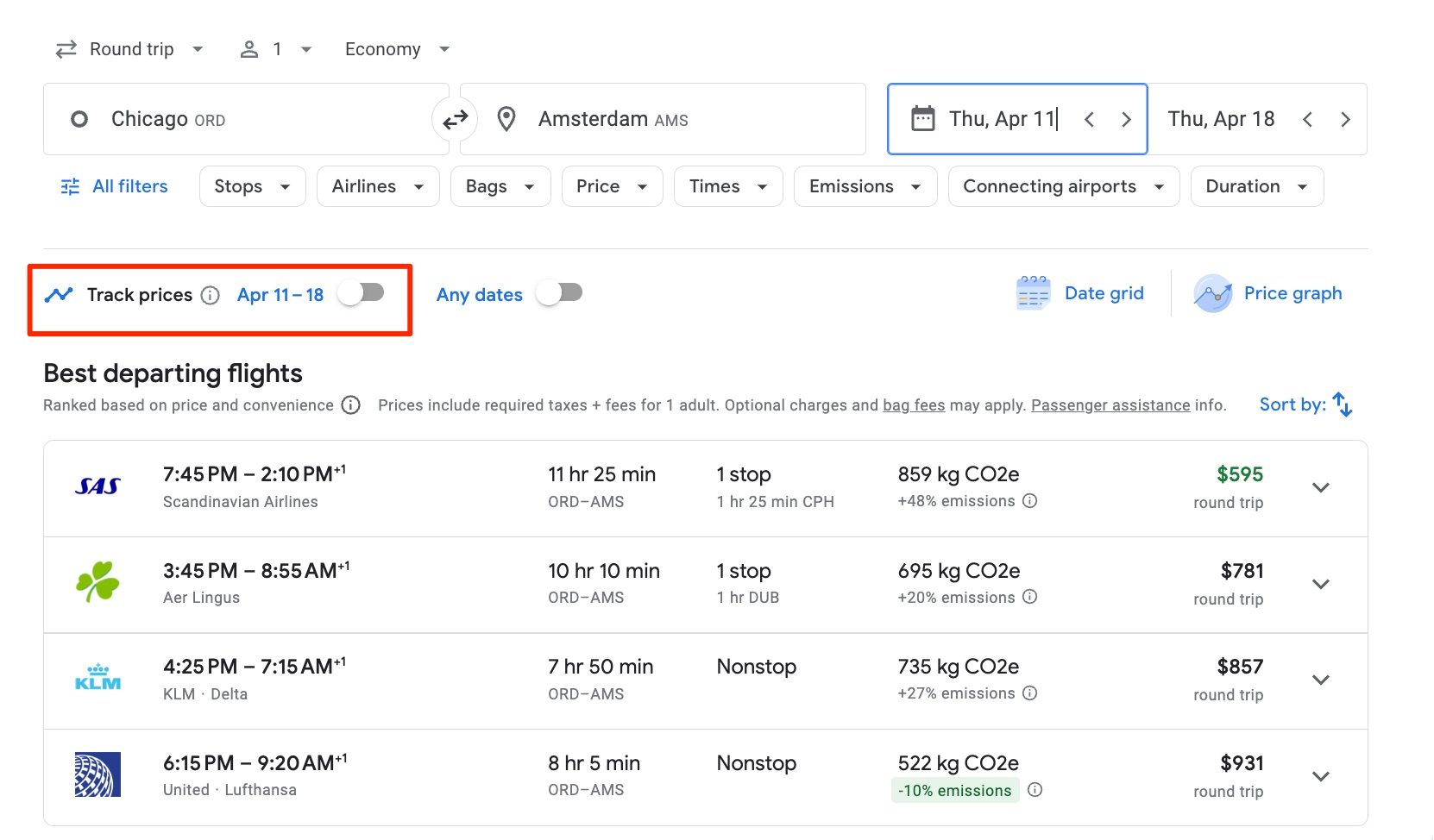
The one requirement for getting these Google Flights price alerts is that you need a Gmail account. Once price tracking is on, you'll get emails whenever the price rises or drops significantly straight to your Gmail inbox.
You can also view all your tracked flights from the menu bar. Just click “Tracked flight prices” and you can pull up the history of all the flights you're currently tracking within your account. You can also toggle email notifications for these price alerts on and off.
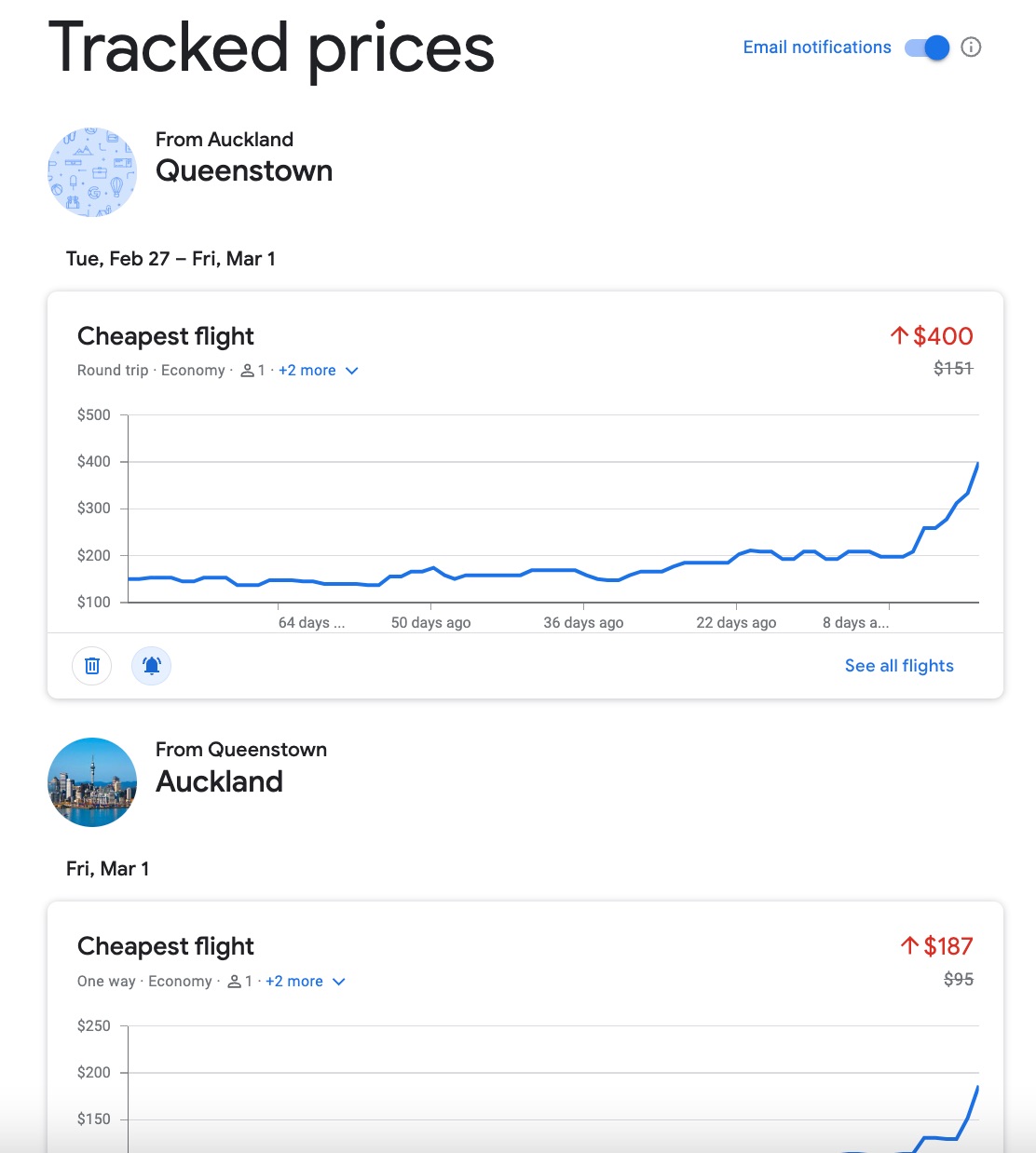
Initially, this feature was only available for specific dates. If you were aiming to book a one-way flight on Sept. 12 but prices decreased on the same route for Sept. 13, that change wouldn't trigger Google's airfare alerts. But now, these price alerts are even more powerful.
A few years ago, Google added the ability to track flight price changes for any date. Just hit that toggle and you'll get an email notification anytime there are airfare prices available on your route that are lower than normal within the next three to six months.

This could come in handy if you're itching to go somewhere in particular but will go whenever you find a good price. Of course, if you're looking for a specific flight only on a certain day, you're better off skipping this new option.
Read the full guide to tracking flight prices with Google Flights.
“Cheapest Time to Book”: Google Flights' Newest Feature
Among the many reasons travelers should be using Google Flights, it's packed with data-fueled information to help steer you towards the best deals. It keeps getting better and better – and another new feature will give you even more insights on the best time to book.
On select searches, Google will now display when prices are typically lowest on the route you're searching – giving you some critical information on whether it's better to book now or wait.

The color-coded price tracking information has been a part of Google Flights for years now, giving travelers a look at how high the price is compared to the average. But now Google Flights is giving you an average booking window, so you can figure out when it's best to book your chosen itinerary.
That's a huge perk for Google Flights users, and it even tells you how much you stand to save by waiting or not! If the savings are negligible, you can even just grab the flights you want for peace of mind, too.
Read More: Want to Know When to Book Your Flights? A New Google Flights Feature Shows You
What Airlines are Not on Google Flights?
The power of Google Flights is that almost every airline is at your fingertips as you search for cheap flights. But the key word is “almost.”
A handful of airlines choose not to list their flights through Google Flights … or other search engines, for that matter. For many, many years, that included Southwest Airlines – one of the largest carriers in the U.S.
Not anymore: You'll now see Southwest prices when searching through Google Flights. See a price you like? You can click through to book with the airline in just a few seconds.
Others haven't followed suit yet. Some popular Asian carriers including Air China, China Eastern, and Thai Airways still aren't always available via this platform.

Frequently Asked Questions
What is Google Flights?
Google Flights is a flight metasearch engine that uses a global distribution system to tap into the flight inventory offered by almost every airline in the world. It is not an OTA (online travel agency) like Priceline or Orbitz.
How does Google Flights work?
It's a metasearch engine tool that pulls up flight schedules, itineraries, and seats in order to show you flight prices on hundreds of thousands of tickets – including taxes. Google also pulls in information on additional fees to avoid basic economy as well as baggage fees.
Once you find the flight you want, you can book directly with the airline – or through an online travel agency. Just like Google itself, Google Flights is purely a search tool: you're not actually booking flights through Google.
How reliable is Google Flights?
Extremely reliable.
Google gets its data directly from each airline (or online travel agency) database. Most times you find an error, it's because of an error on the airline's end – not Google's. That said, because flight prices are changing constantly, sometimes Google will erroneously display an out-of-date price that has since changed due to cached data. This typically gets fixed within minutes, if not seconds.
Because you generally wind up booking with the airline, there's no need to worry about getting the flight you just paid for.
How do I cancel a ticket booked through Google Flights?
Because you're not actually booking through Google, there's no need to go through Google if you need to change or cancel your tickets.
Instead, you'll have to go through however you booked: your airline or the online travel agency you used. Google can't help you.
Keep in mind that the U.S. Department of Transportation has a “24-hour rule” that requires airlines to give you a full refund if you cancel your flight within 24 hours of booking. This rule applies to all flights that touch U.S. soil on any airline (foreign or domestic). And while the rule only requires full refunds for flights booked directly with the airline, some of the bigger online travel agencies have the same policy.
Are all airlines available?
Almost every major (and many minor) airline is available through Google's search tool, but there are some notable exceptions.
Southwest Airlines was the biggest airline missing from Google, as the beloved low-cost carrier didn't list its flights anywhere other than its own website. But that finally changed in 2024. Allegiant Air was also missing for years, but you'll see Allegiant now too.
Several larger Asian airlines are still missing from Google's flight search engine, including China Eastern, Air China, and many Thai Airways flights.
How do you search for flexible dates on Google Flights?
Easy. Google practically does it for you.
Just enter your flight and dates and then click on dates in your search, and Google will pull up a handy two-month calendar. Scroll through and you'll see the lowest prices available in green. The search tool may also give you a pop-up notification when changing your travel dates by a day or two could result in some serious savings.
How do you change your search currency?
Just scroll down to the bottom of any Google Flights page, and you'll see the currency option. Click it and switch to whichever currency you'd like your flight results displayed in!
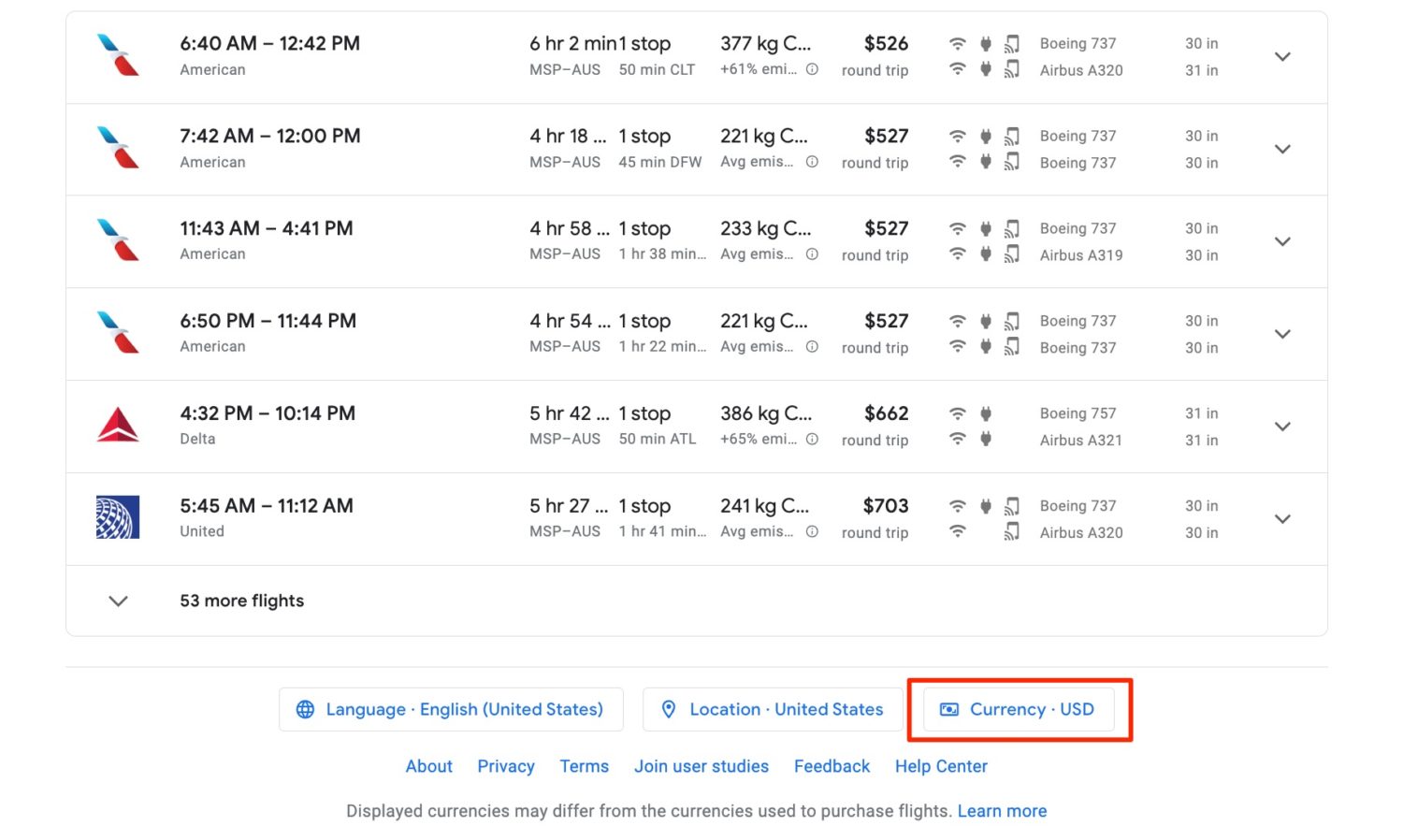
Bottom Line
Google Flights should be your go-to tool for booking your next trip. We dig through thousands of flights every day, and it is, without a doubt, the most robust tool to find amazingly cheap fares.
It's leaps and bounds better than any other flight searching tool, with more features that will help you find the best deal every single time.


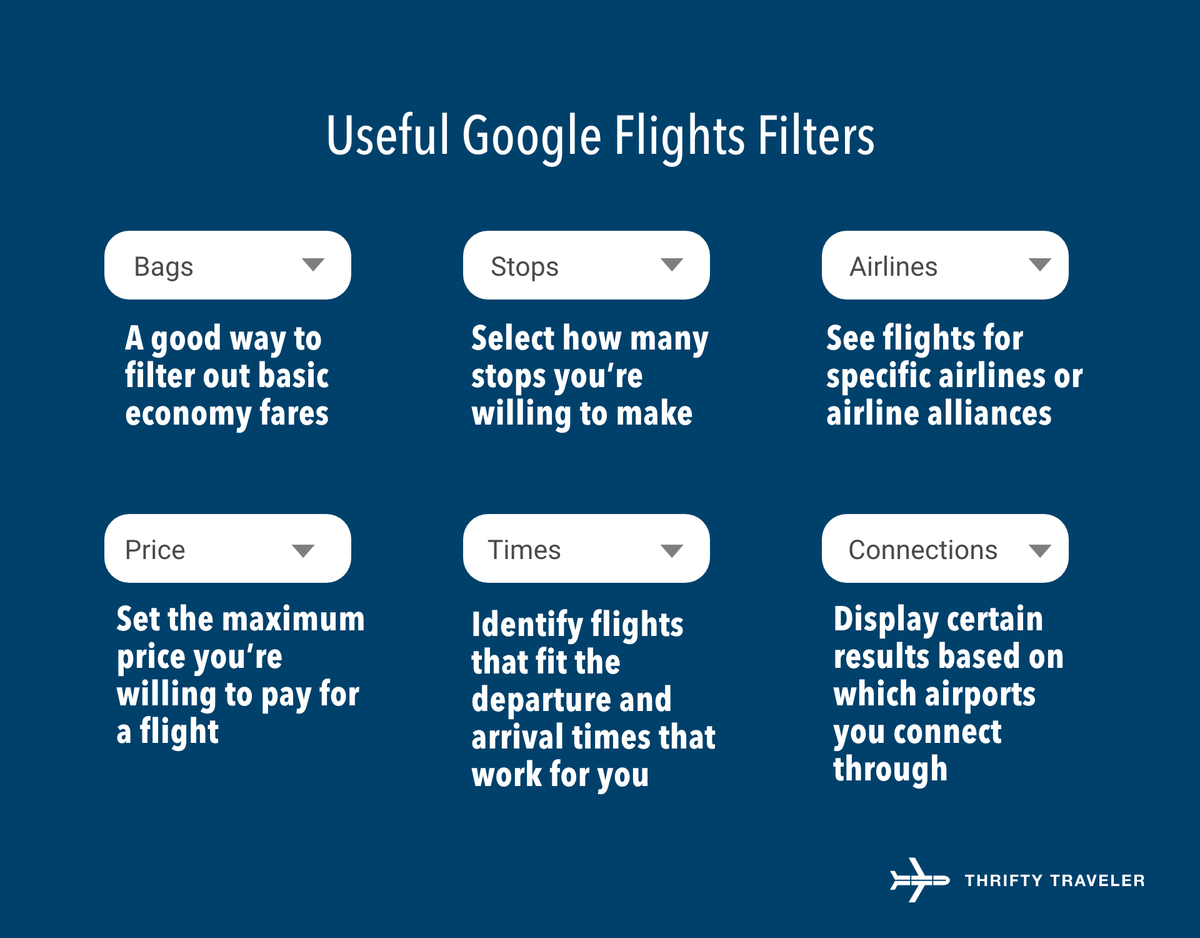
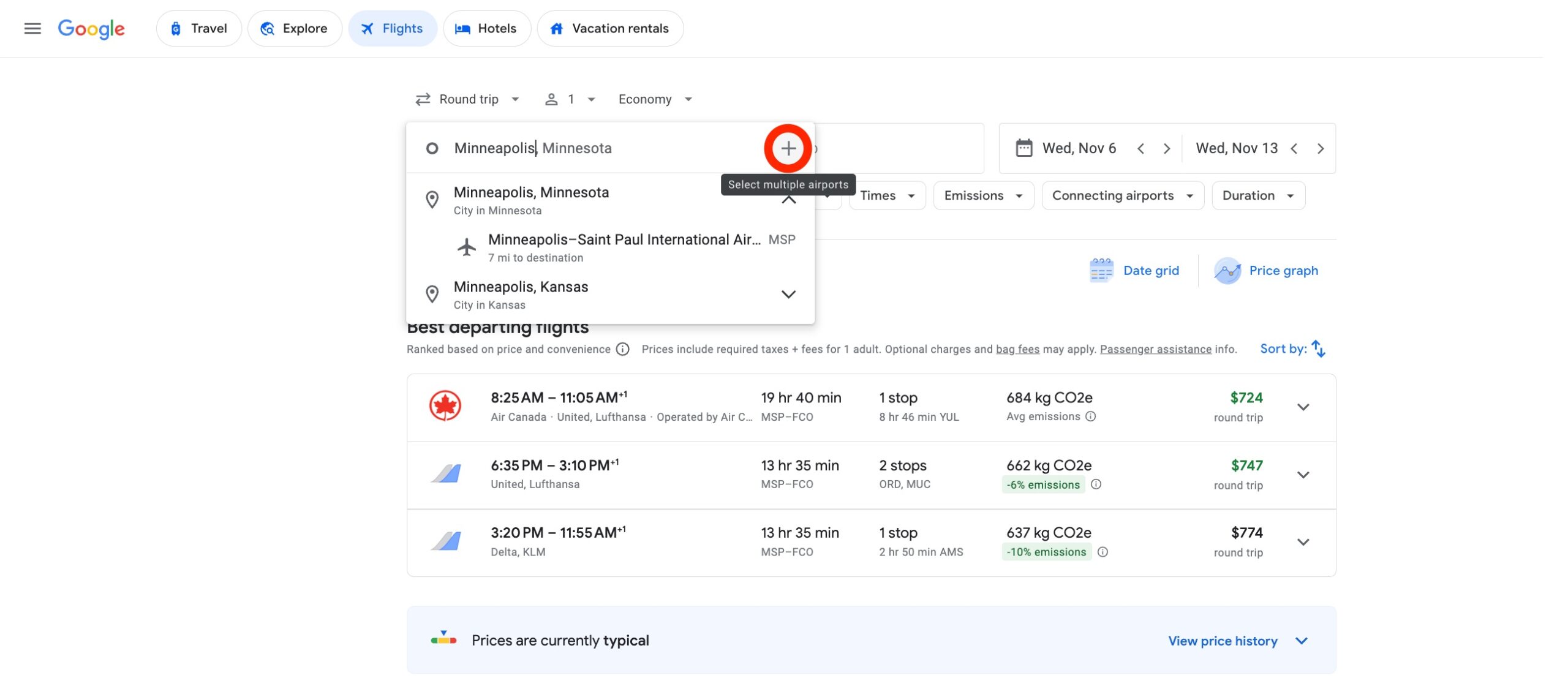
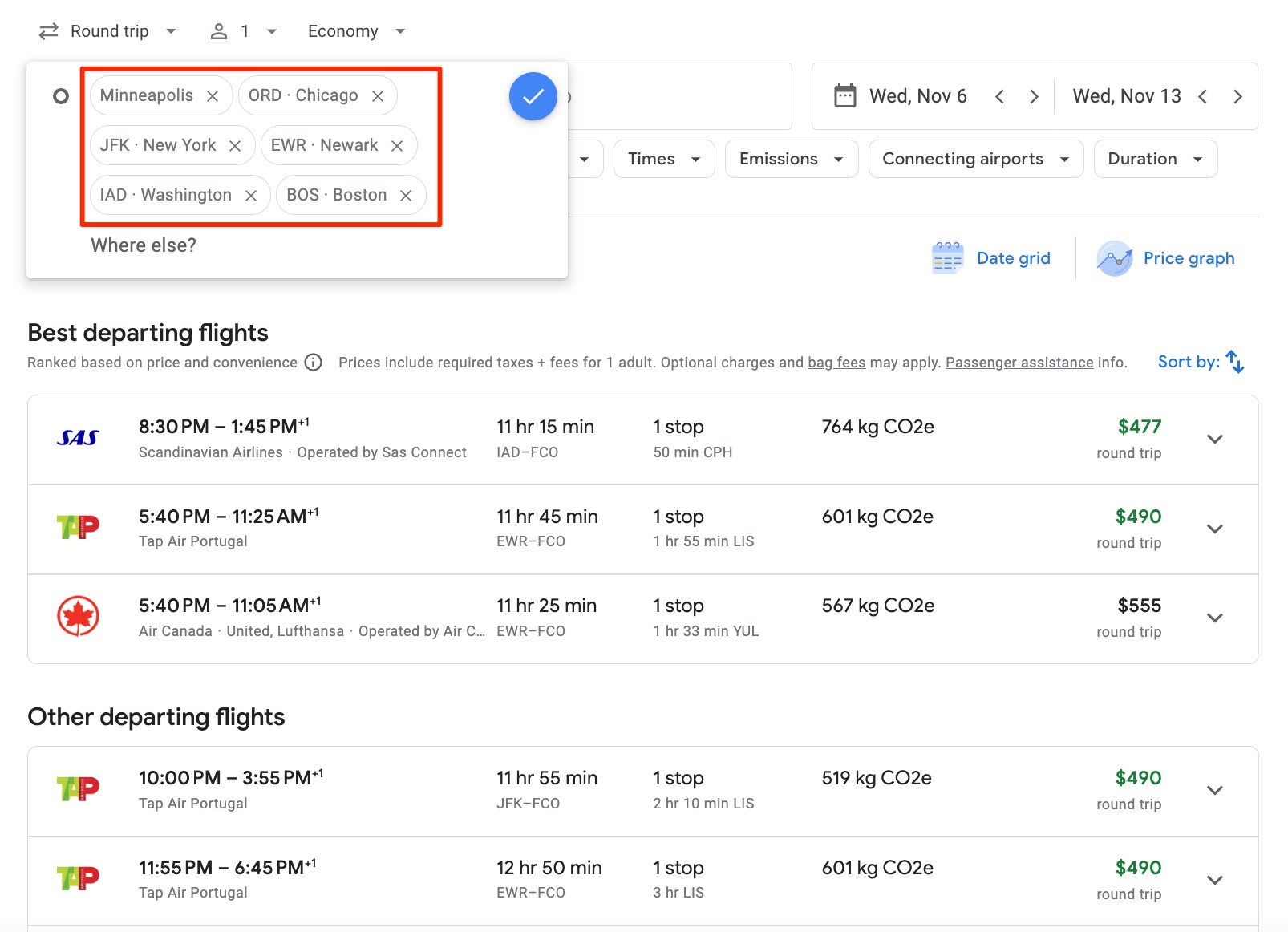



















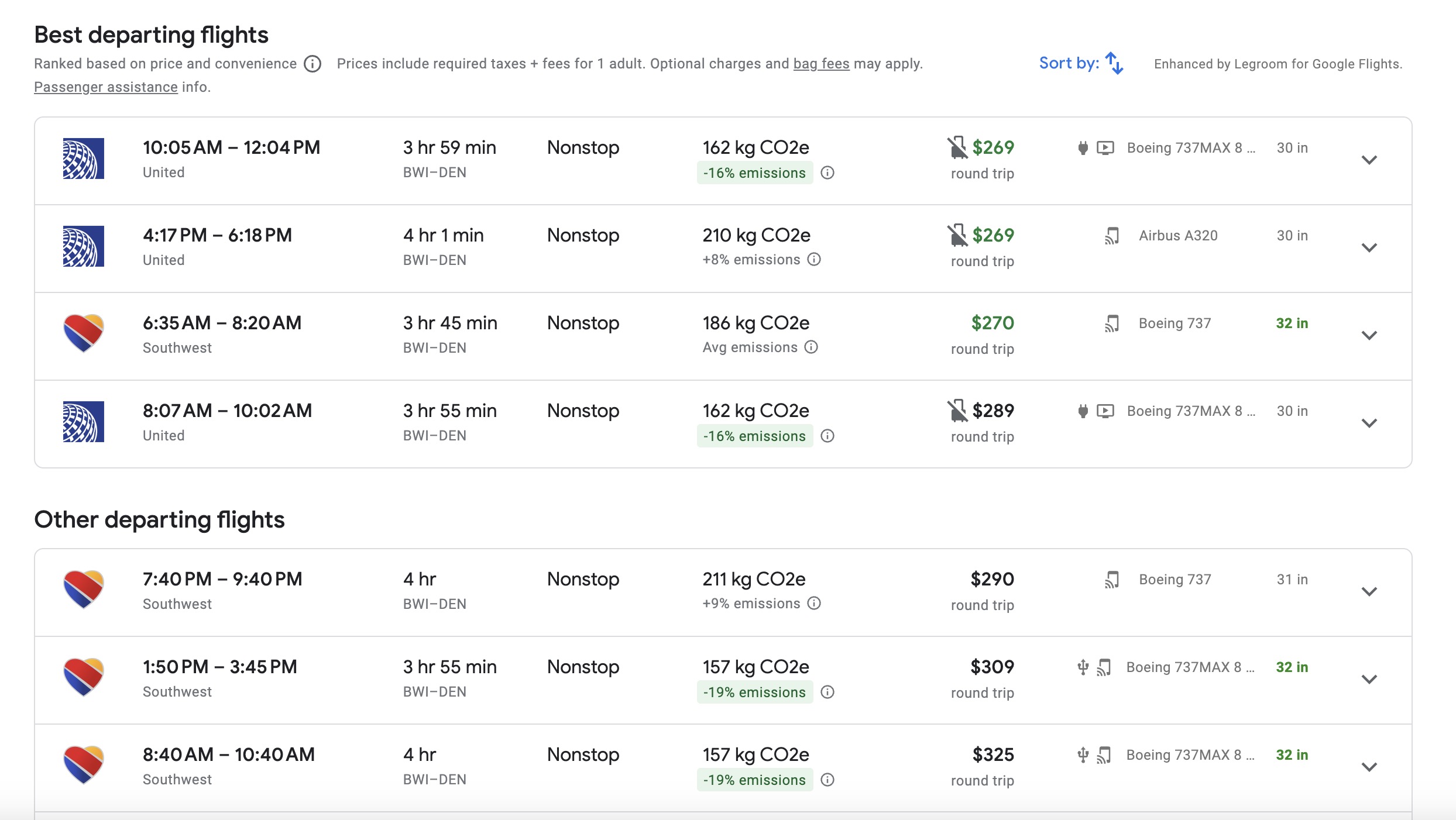
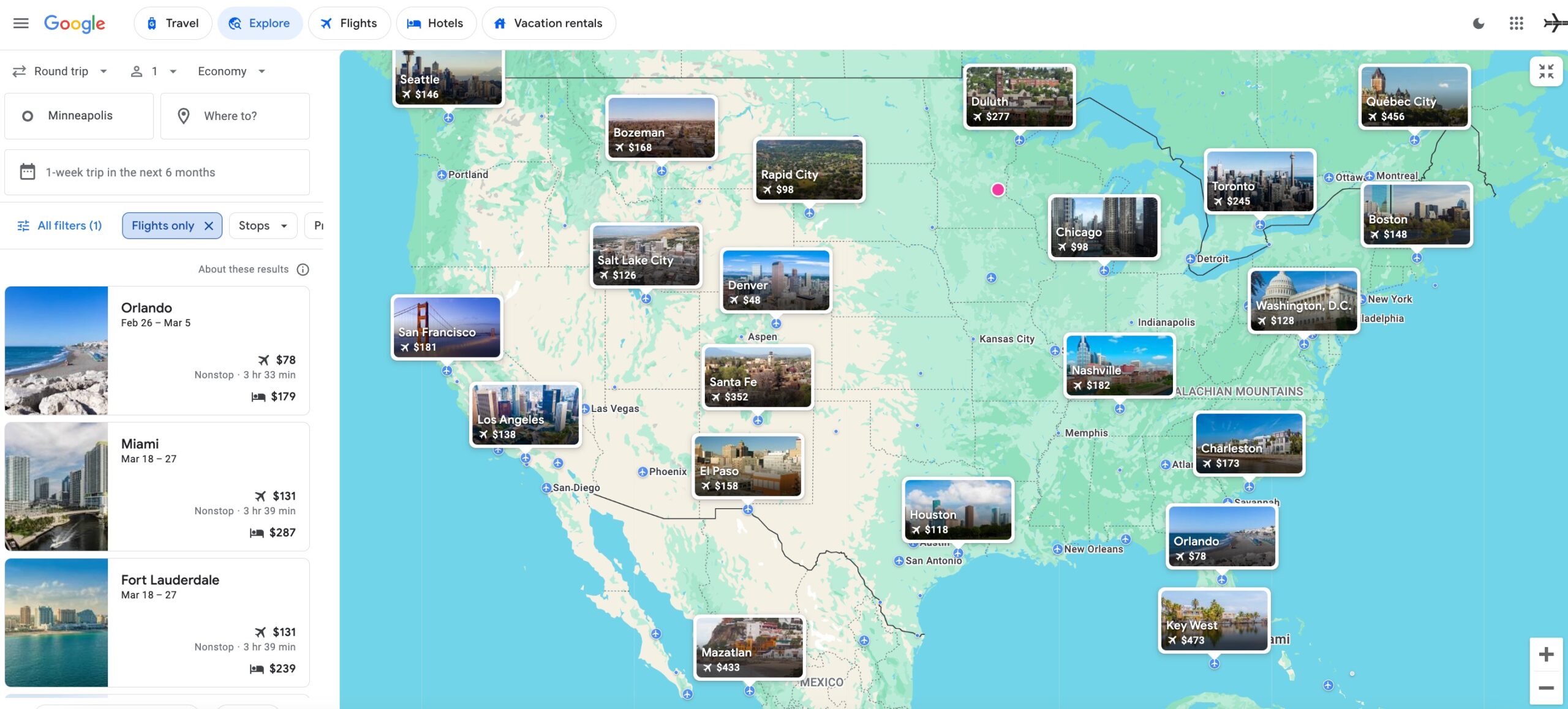



thanksss this is really helpful
I believe JetBlue is now allowing a free carry on its Blue Basic fares, so United is the sole USA carrier not allowing a free carry on in basic economy. Also, I have found when searching for flights outside USA, searching United, American, and Delta websites will show bookable results for their Star Alliance, OneWorld, and SkyTeam partners often at lower prices than Google Flights (or the partner airlines own websites) have for the same routes, and often gets alliance benefits regardless of elite status (eg when I booked a British Airways economy seat on aa.com from London City Airport to Malaga aa.com assigned me automatically to a preferred (the bulkhead, in fact) aisle seat when no other aisle seats were available for me to select even though I have no elite status with American (or British), so I view booking non-USA airlines flights through their USA alliance partners as the one exception to the rule of always booking flights directly with the operating airline.
Well, I was excited to try Google Flights after spending so much time researching individual airline and OTA websites. However, the same flights I found on British Airways’ website that were perfect for our planned trip and destinations, and which cost $1,470 total (economy, 1 checked bag included) were shown on the Google Flights page at $3,379. In fact, the least expensive flights listed on Google Flights for the destinations for which I was searching were more than $100 – $200 higher than those I found through my own research on airline websites directly. So much for Google Flights saving so much money by finding the least expensive flights available.
Google flights is useless for international flights now that they insist on showing Basic Economy as their default price. That’s hot garbage. People aren’t flying international w/a backpack unless they’re in college. Anyone would want or expect Main Cabin as the price they’re using as their benchmark, not the deceptively low, irrelevant Basic Economy price, which is what publishes.
So, if you set the Google Flights “Baggage” setting to look for Free Carry-on, you’ll leave the Basic Economy stuff out of your search results. That may get you closer to the kind of search results you want?
Please REMOVE Kiwi.com from the Google Flights site. My ongoing Assisted Refund experience, due to a cancellation by Finnair, has been horrific! It has been in progress since August 31, 2022 and the end is no where in site as of December 27, 2022. I am in this situation due to no fault of my own and am at the mercy of a non-transparent, non-cooperative company that expects me to just keep patiently waiting for a refund on a $4052.37 ticket!! PLEASE spare other uninformed users of your site of this common infuriating experience!
yes, your website doesn’t allow me to book a flight. I am looking for the cheapest round tip flight from Las Vegas, Nevada to Shanhai, China.
very confusing !!!!!
Not sure when this article was published originally, but I think the option to display price range chart (that tells you if the price is cheap or expensive range) under [What’s a Good Flight Deal? Google Flights Will Tell You] is no longer available?
I just found your site and have used OTS many times. I have a credit with United due to the 2020 Covid travel issues. My question is if I book with Google Flihts or join Thrifty Travel will I be able to use the credit I have. I stand to loose it in 2023.
You can’t book ythru Google flights you have to go to airliine site to do that. Best to talk with customer service for the airliine you use on credit use. I knoow nothing about Thrifty’s policies.
Is Google Flight search and thrifty traveler one of the same? and if not, why do I need thrifty traveler premium for $59/yr. when your telling me Google does the same free? very confusing!
Google Flights is a great tool and one we use in addition to some other proprietary tools to find the deals we send to Thrifty Traveler Premium members. You are, of course, welcome to search for yourself for free using Google Flights. But the value of our Premium service is that we search for deals all day, every day, using these and more tools to take the legwork out of finding a great flight deal so all you have to do is book and save!
Allegiant is on Google Flights now 🙂
Allegiant is on google flights. 👍🏼
How do you hide those annoying photos that have started appearing on the Google Flights Explore map? This is a terrible UI change – there must be some way to turn it off since they block views for so many secondary locations.
Fo you have the cheapest flight to Orlando that’s not spirit I’m trying to get united
Looks great.
If you are willing to fly different airlines and add connections this can be true. We focus on nonstop or one connection on the same airline. Keeping it simple does have it’s advantages and disadvantages. Generally, one-ways are only cheap on domestic flights, not international ones.
Due to covid-19 and voucher we recommend avoiding online OTAs like Expedia. Yes you can save $10-20 from time to time but it’s not worth the headache if you run into an issue: https://thriftytraveler.com/book-flights-with-airline-not-otas/
I recently started using Skyscanner and saved ~$25 on a one way flight from IAH to MEX.